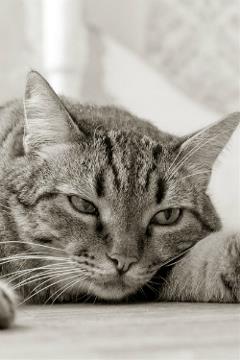Feline Urinary Tract Disorders: Connecting Behavioral Problems with Medical Issues

Feline Lower Urinary Tract Disease (FLUTD)
Feline Lower Urinary Tract Disease (FLUTD) disorders can negatively impact the health and life of an animal. In cases of animals with FLUTD, not only is the animal physically sick, but sometimes the symptoms of the disease will put it at risk for being placed outside of the home or relinquished to a shelter. Clients need to be aware that there are times when behavioral problems stem from medical issues.
Frequency
FLUTD can occur in cats of all genders, ages, and breeds, but is most typically diagnosed in animals found to be:
- Middle-aged
- Neutered
- Overweight
- Indoor cats with little exercise and limited access to outdoor areas
- On a dry food diet
Common Symptoms
When associating illness to behavior, the potential causes of FLUTD can directly relate to an animal’s bad behaviors that are not welcomed, especially when the animal lives indoors. Before negative situations arise, advise clients to watch their pet for behavioral changes and for symptoms that could indicate developing conditions of FLUTD. For example:
- Straining to urinate
- Crying in pain when urinating
- Increased frequency of urination
- Urinating in abnormally small amounts
- Urinating in places outside of the litter box
- Pink-tinged urine
- Inability to urinate
- Lack of appetite
- Loss of desire for human contact
- Irritability
- Depression
- Hiding
- Increased or excessive grooming
Common Causes
Informing clients of the potential causes of FLUTD is important as it will help them to connect the observed symptoms with the physical reasons. For example, two of the common underlying causes of FLUTD include:
- Interstitial cystitis
- Thought to be related to an animal’s stress
- Causes inflammatory changes within the bladder and also results in other lower urinary tract disease conditions
- Will exhibit behavioral symptoms such as:
- Urinating outside of the box
- Crying when urinating
- Inability to urinate
- Thought to be related to an animal’s stress
- Urethral obstruction
- Is the most serious of the causes of FLUTD
- Obstructions commonly occur in males because the urethra is much narrower
- Obstructions may include:
- Bladder stones
- Urethral plugs
- Although obstructions rarely occur in females, when they do they may include:
- Tumor or developing mass
- An animal with an obstruction:
- Is unable to urinate
- Will exhibit symptoms including:
- Straining
- Pain
- Depression
- Vomiting
- Lethargy
- When the body cannot rid itself of waste products, the level of toxicity rises, accumulating in the bloodstream and poisoning the body
- If not treated, urethral obstructions can be fatal
Prevention
While prevention of FLUTD is not always possible, advising clients of the following recommendations may help them help their pet fight off a urinary tract disease:
- Water
- Provide animal with fresh water at all times to encourage increased water consumption
- Cats seem to be enticed by water fountains and/or dripping faucets
- Diet
- Cats on a dry food only diet tend to be at higher risk for FLUTD
- Adding water to the dry food diet is helpful
- Supplementing a dry food diet with additional wet canned food will also increase water intake
- Stress
- Eliminate stress caused by outside influences, for example:
- Teach children to either leave pet alone or to handle it calmly so animal feels safe and not threatened
- Establish a quiet place where the pet can rest without being bothered
- Increased environmental enrichment will help to reduce stress for indoor cats
- Offer toys, boxes or places to hide, climbing and scratching posts
- Eliminate stress caused by outside influences, for example:
- Litter box
- Place box in an area where pet will not be disturbed
- In multi-cat households, make sure to provide an adequate number of boxes
- Maintain cleanliness of litter box
Clients unaware of the physical symptoms of FLUTD may incorrectly assume their pet is behaving badly, and will forego bringing their animal in for an examination. When working with cat clients, take the time to initiate a discussion that creates awareness of an animal’s need for a veterinary examination based on the owner’s observance of physical and behavioral symptoms.
Want to learn more?
Please join us for a Free Webinar presented by Covetrus and Purina to learn more about the ways therapeutic diets can support the urinary tract health of cats and dogs!
Free Webinar: The Nutritional Management of Canine and Feline Urinary Conditions
Thu, Mar 10, 2016 2:00 PM - 3:00 PM EST
Presented by Steven R. Cohn, DVM, Veterinary Communications Manager, Nestlé Purina PetCare Company
Webinar attendees will earn 1.0 hour of CE credit - REGISTER NOW
Sources:
http://www.petmd.com/cat/centers/nutrition/evr_ct_feline-urinary-tract-disease
Careers
Are you looking for a place to let your talents shine? At Covetrus, we help our practitioner customers better serve their patients and take pride in providing the best customer experience possible. Search our open positions to see our available opportunities.
Newsletter
Stay current with what’s going on with Covetrus, subscribe to receive our newsletter and email communications. Subscribers will receive the latest information in practice management, sales and marketing, animal health, and more.


Leave a comment